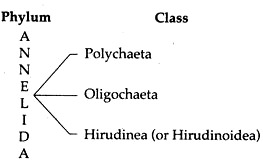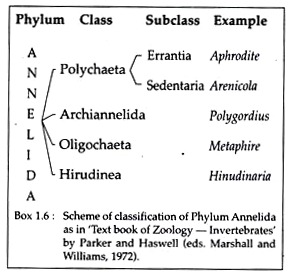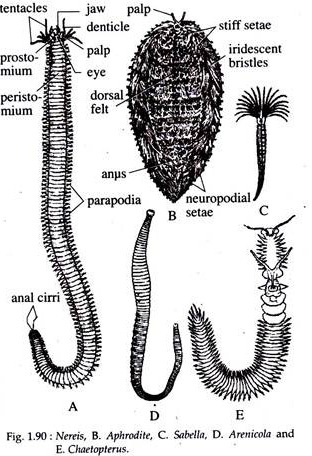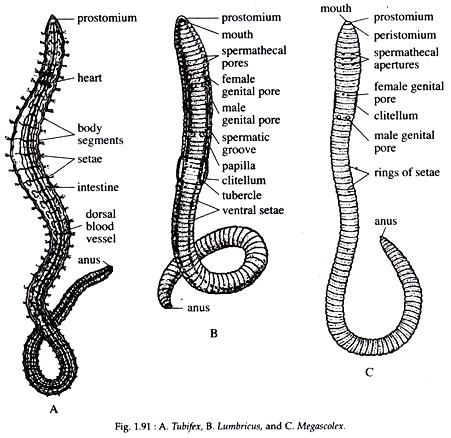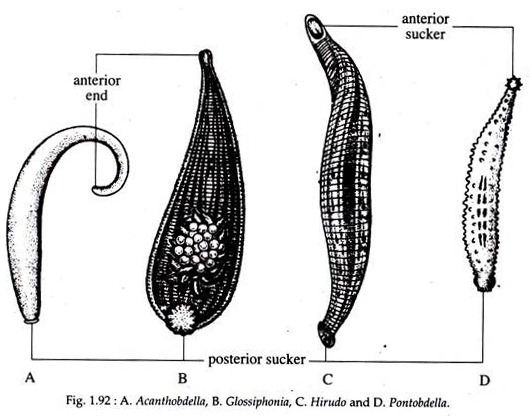In this article we will discuss about Phylum Annelida:- 1. Introduction to Phylum Annelida 2. Diagnostic Features of Phylum Annelida 3. Scheme of Classification 4. Systematic Resume.
Introduction to Phylum Annelida:
The phylum Annelida exhibits great diversity of body form. They are segmented worms and are thus distinguished from other worms like flat worms, round worms and so on. They include the familiar earthworms and leeches, in addition to a number of marine and fresh water species. They vary in size ranging between < 1 mm and the largest, the giant 3 m. long earthworms of Australia.
Etymology:
Latin: annellus or annelus, a diminutive of anulus, a ring.
Diagnostic Features of Phylum Annelida:
ADVERTISEMENTS:
1. Body vermiform and bilaterally symmetrical.
2. The body is metamerically segmented, the division of the body into similar segments are arranged in a linear series along the anteroposterior axis.
3. The body cavity is true coelom, which is lined by a peritoneum or coelomic epithelium and serves as a hydrostatic skeleton against which muscles can contract.
4. Body cavity often sub-divided by transverse septa.
ADVERTISEMENTS:
5. The body wall consists of an outer epithelium covered by a cuticle and with epidermal bristles or chaetae in bundles or singly.
6. Body wall muscular, often with complete circular muscle layers and four blocks of longitudinal muscle.
7. A pre-segmental prostomium containing a nervous ganglion and a post-segmental pygidium is present.
8. Presence of a muscular gut with mouth and anus.
ADVERTISEMENTS:
9. Closed blood circulatory system.
10. Excretion takes place by means of metamerically arranged pairs of coiled tubes called nephridia.
11. The animals are often provided with coelomoducts which are channels for the outward passage of reproductive elements.
12. Nervous system consists of pre-segmental supra-oesophageal ganglion, circumoesophageal ring and a ventral nerve cord with segmental ganglia.
13. Development in marine forms are sometimes via a free-living trochophore larva.
Scheme of Classification of Phylum Annelida:
The annelids were previously termed as “worms” and were grouped under the old phylum Vermis. Cuvier in 1798 pointed out the fundamental differences and separated them from vermis. Later in 1909, Lamarck coined the name Annelida.
There are about 15,000 living species which have been classified broadly into 3 main groups. The classification followed in this text is according to the classificatory plan outlined by Ruppert and Barnes, 1994 (6th edn.)
Systematic Resume of Phylum Annelida:
Class Polychaeta (Greek: Poly, many; chaeta, bristles)
ADVERTISEMENTS:
1. Predominantly marine with errant and sedentary habit. Errant species exhibit swimming, crawling, burrowing or tube dwelling habitat while sedentary polychaetes are either burrowers or tube dwellers.
2. Presence of numerous chaetae or bristles, inserted in two groups (rather than singly) in the biramous segmental Para podia.
3. Distinct head bearing eyes, tentacles, cirri and palps.
4. Pharynx with (errant types) or without (sedentary types) jaws or teeth.
5. Alimentary canal is usually straight. The buccal cavity has muscular wall and is often eversible, while pharynx which also has muscular wall is often protrusible.
6. Mostly dioecious but a few are hermaphrodite. Gonads escape either by rupture of the body wall or through the nephridia.
7. Polychaetes have great power of regeneration of some body parts like tentacles, pulps and even a head.
8. Larva typically a free-swimming trochophore which undergoes metamorphosis.
Examples:
Nereis (Fig. 1.90A), Aphrodite (Fig. 1.90B), Chaetopterus (Fig. 1.90E), Arenicola (Fig. 1.90D), Sabella (Fig. 1.90C).
Class Oligochaeta
(Greek: Oligos, few; chaeta, setae)
1. Mostly terrestrial and fresh water forms with secondarily marine representatives.
2. Head indistinct, prostomium is either small, rounded lobe or a small cone without appendages.
3. Body segments lack Para podia but have setal sacs, from which setae emerge as group or bundle.
4. Presence of clitellum.
5. Asexual reproduction by spontaneous fission (schizogenesis).
6. Hermaphrodites with distinct gonads restricted usually to a few anterior segments.
7. No free larval stage in development.
Examples:
Metaphire (Fig. 1.93), Pheretima, Lumbricus (Fig. 1.91B), Tubifex (Fig. 1.91 A), Megascolex (Fig. 1.91C), Aeolosoma
Class Hirudinea/Hirudinoidea (Latin: hirudo, Leech)
1. Fresh water, marine or terrestrial.
2. Dorsoventrally flattened, pigmented body made of 33 segments, marked externally by secondary rings or annuli.
3. Usually two suckers are present a powerful posterior sucker and a small anterior or head sucker surrounding the mouth.
4. Tentacles, Para podia and setae are absent.
5. Coelom much reduced and filled by connective tissue.
6. Nervous system with segmental ganglia for the co-ordination of complex behavioural and locomotory patterns.
7. Hermaphrodite, with several pairs of testes, a pair of ovaries and a single genital opening.
8. Development direct, without a larva.
Examples:
Hirudinaria, Hirudo (Fig. 1.92C), Acanthobdella (Fig. 1.92A), Glossiphonia (Fig. 1.92B), Pontobdella (Fig. 1.92D), Dina.
